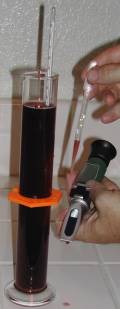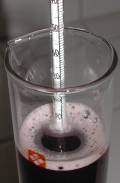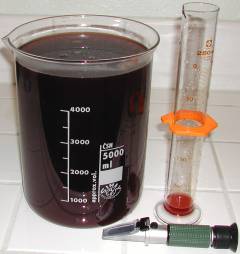Hydrometer of 250mL vs 2 drops on a Refractometer. Note the
eyedropper above the refractometer.

Hydrometers break, are messy, vary due to temperature, fermentation (CO2) and the precision of your tool. Each time you use a hydrometer you must:
1.) Sanitize the hydrometer, beaker and Siphon
2.) Pull 250mL out of your tank,
3.) Carefully insert the hydrometer (I've broken a few in the past)
4.) Spin the hydrometer to knock the bubbles off and try to read the still spinning gradient before the bubbles take hold and skew the reading again.
5.) Then adjust the measurement for temperature as Hydro's are calibrated at 60 0F.
6.)
Finally return the wine back to the fermenter and hope you didn't introduce
too many contaminants into the batch during the analysis.
Multiply this activity 2 times each day and you begin to wish there was an
effective alternative.
A refractometer with ATC (Auto Thermal Compensation) is unaffected by temperature, fermentation gases and only takes one to two drops to measure the sugar content of your must. However, it is effected by the different refractive index of ethanol. As the amount of alcohol increases the refractive index changes algorithmically. Unlike a Hydrometer the reading in a refractometer will never go to zero.
With a Refractometer you:
1.) Fill an eye dropper with a couple drops of juice
2.) Drip a drop or two on the refractometer lens
3.) Read the refractive index through the refractometer
In theory the ethanol effect is predictable and a formula should be able to compensate for it's refractive change.
To test the theory we fermented a Zinfandel kit and took measurements with both a professional refractometer and precision hydrometer using a formula from the CRC Handbook of Chemistry and Physics ("Concentrative Properties of Aqueous Solutions: Conversion Tables", 69th Edition Table 88 Sucrose). We then evaluated the correlation between the formula compensated refractometer readings against those from a precision hydrometer from start to finish of fermentation.
The formula tracked like rocket science. Over the 10 day fermentation we averaged less than 1% difference and that falls into the realm of user error.
Check our test results and download the file for your own use!
Our experiment results ( in .pdf)
Spread sheet to auto compensate for ethanol effect on a refractometer during fermentation (.xls Requires MSN Excel).
Formula for compensation of ethanol effect on refractometer: SG=1.001843-0.002318474(OB)-0.000007775(OB^2)-0.000000034(OB^3)+0.00574(AB) +0.00003344(AB^2)+0.000000086(AB^3)
SG = Specific Gravity, OB = Original Brix, AB = Actual Brix (Brix Readings During Fermentation)
Formula to convert from SG to Brix (for those who prefer Brix measurements):
Brix (Plato) = -676.67 + 1286.4*SG - 800.47*(SG^2) + 190.74*(SG^3)
Temperature compensation formula for hydrometers calibrated at 600F:
Correction = 1.313454 - 0.132674*F + 0.002057793*(F^2) - 0.000002627634*(F^3)
SG corrected = SG + (correction * 0.001)
Bubbles during fermentation attach to the hydrometer and skew your reading. Temperature adjustments are also necessary as most hydrometers are calibrated at 60 0F.

During our experiment we pulled 5750mL (1.5 Gallons) for the twice
daily hydrometer readings. Compare to the 10ml of juice at right for
a refractometer. Note that the small samples for the refractometer
are not reintroduced back into the fermenter. Greatly reducing risk
of contamination.
